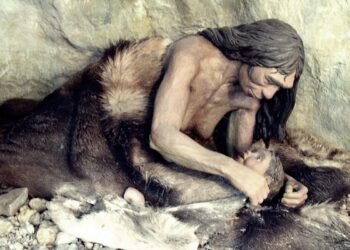An international team of researchers from Chinese, Australian, and US institutions has unraveled the mysteries surrounding the extinction of Gigantopithecus blacki, the largest primate ever to walk the Earth.

The study, published in the journal Nature, sheds light on the colossal ape’s demise between 295,000 and 215,000 years ago, exposing its inability to adapt to a changing environment.
Gigantopithecus blacki, often referred to as the “real-life King Kong,” once roamed the lush karst plains of southern China, towering at three meters tall and weighing over 250 kilograms. Discovered by anthropologist Ralph von Koenigswald in 1935, the species is only known through approximately 2,000 fossilized teeth and four jawbones.
For over 85 years, the extinction of G. blacki remained a perplexing enigma in paleontology. Palaeontologist and co-lead author Professor Yingqi Zhang, from the Institute of Vertebrate Palaeontology and Palaeoanthropology at the Chinese Academy of Sciences (IVPP), states, “The unresolved cause of its disappearance has become the Holy Grail in this discipline.”
To crack this longstanding puzzle, a multidisciplinary team conducted a comprehensive regional analysis, examining evidence from 22 caves in Guangxi Province, southern China. Luminescence dating, uranium series, and electron-spin resonance techniques were employed to establish a definitive timeframe for G. blacki’s extinction between 295,000 and 215,000 years ago.
Associate Professor Kira Westaway, a geochronologist from Macquarie University and co-lead author, emphasizes the significance of a precise timeline, stating, “Without robust dating, you are simply looking for clues in the wrong places.” The research involved six Australian universities, with contributions from Macquarie University, Southern Cross University, Wollongong University, and the University of Queensland.
Detailed pollen analysis, fauna reconstructions, stable isotope analysis of teeth, and micro-level analysis of cave sediments revealed the environmental conditions leading to G. blacki’s extinction. The study unveiled a thriving population of G. blacki in a rich and diverse forest around 2.3 million years ago. However, by 700,000 to 600,000 years ago, changing environmental conditions, marked by more seasonal climates and alterations in forest structure, led to the decline of G. blacki.
Comparisons with orangutans (Pongo), close relatives of G. blacki, showed the adaptability of the latter. Orangutans adjusted their size, behavior, and habitat preferences, while G. blacki, an ultimate specialist, struggled with a less nutritious fallback food source, reduced mobility, and chronic stress. Professor Zhang notes, “G. blacki was the ultimate specialist, compared to the more agile adapters like orangutans, and this ultimately led to its demise.”
Associate Professor Westaway says: “With the threat of a sixth mass extinction event looming over us, there is an urgent need to understand why species go extinct. Exploring the reasons for past unresolved extinctions gives us a good starting point to understand primate resilience and the fate of other large animals, in the past and future.”























There was a whole lot going on on this planet before we came along. If all these species became extinct, does that mean us humans could become extinct too and evolve into something else? I have heard that many of our babies are born without wisdom teeth. That’s a change. This is all so incredibly interesting. I love it.